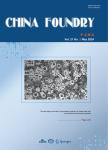Effects of heat treatment on microstructure evolution and mechanical properties of Mg-6Zn-1.4Y-0.6Zr alloy
Effects of heat treatment on microstructure evolution and mechanical properties of Mg-6Zn-1.4Y-0.6Zr alloy作者机构:State Key Lab of Materials Processing and Die & Mould Technology Huazhong University of Science and Technology Wuhan 430074 China
出 版 物:《China Foundry》 (中国铸造(英文版))
年 卷 期:2017年第14卷第3期
页 面:199-204页
核心收录:
学科分类:08[工学] 0806[工学-冶金工程] 0805[工学-材料科学与工程(可授工学、理学学位)] 080502[工学-材料学]
主 题:镁合金 加热处理 微观结构 机械性质 TG146.22 A
摘 要:To investigate the effects of solution temperature and the decomposition of I-phase on the microstructure, phase composition and mechanical properties of as-cast Mg-6Zn-1.4Y-0.6Zr alloy, solution treatment at 440 oC, 460 oC and 480 oC and further aging treatment were conducted on the alloy. The results indicate that the net-like intermetallic compounds(mainly I-phase) dissolve into the α-Mg matrix gradually with the increase of solution temperature from 440 oC to 480 oC. Besides, the I-phase decomposes completely at 480 oC, with the formation of fine W-phase(thermal stable phase) and Mg_7Zn_3 phase. In addition, a great number of fine and dispersive Mg-Zn binary phases precipitate in the α-Mg matrix during the aging treatment. Due to the increase of solute atoms and the precipitation of strengthening phases, such as W-phase and Mg-Zn phases, the optimal strength is obtained after solution treatment at 460 oC for 8 h and aged at 200 oC for 16 h. The yield strength(YS), ultimate tensile strength(UTS) and elongation are 208 MPa, 257 MPa and 3.8%, respectively. Compared with the as-cast alloy, the increments of YS and UTS are 117% and 58%, respectively, while the decrement of elongation is 46%.



